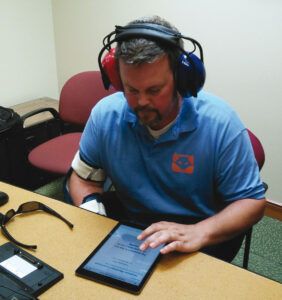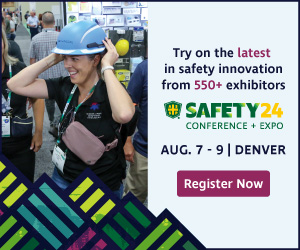Listen Up! From the NHCA Experts…
Audiometric Monitoring: Boothless Audiometry is a Reality

Noise level measurements demonstrating ambient noise is unpredictable and variable. (photo courtesy NHCA)
Workers undergo millions of hearing tests as part of hearing conservation programs (HCP) each year, which are conducted within a sound booth to control background noise. The use of a sound booth often requires a worker to travel offsite to the test location or, sometimes, a mobile trailer travels to the worksite—both of which are more costly for the employer.
Recently, there have been advances in our understanding and application of “boothless audiometry” for occupational hearing testing. You may be surprised to learn that essentially any audiometer can be used outside of a sound booth, as long as the earphones/headphones attenuate enough of the background (ambient) noise in the room at the time the hearing test is administered (see photo).
Controlling ambient noise is necessary to assure valid hearing threshold measurements. If ambient noise levels are too high, the hearing threshold will become artificially elevated. Ambient noise levels for audiometry should not exceed the maximum permissible ambient noise levels (MPANLs) specified in ANSI S3.1-1999 (R2018).
Attenuation of the ambient noise is determined by the fit and seal of the transducer (headphone/earphone) on the ear of the listener—regardless of what audiometer is used. When considering boothless audiometry, it is important to determine if the attenuation of the transducer has been measured according to ANSI S12.6-2016 (R2020) and MPANLs, calculated using Appendix A of ANSI S3.1.
Noise measurement calculators are available. One should ensure that the technician/audiologist is fitting the transducer properly for each hearing test. Ambient noise should be monitored and recorded during the test session, since it can vary greatly (see chart). Boothless audiometry is a reality for those who understand the principles behind the effects of ambient noise and take steps to ensure valid testing. Learn more https://tinyurl.com/yhhryuy4.
Deanna K. Meinke, University of Northern Colorado, is a Professor/Audiologist and National Hearing Conservation Association (NHCA) Expert. Visit NHCA at: https://www.hearingconservation.org/
Share on Socials!
The Amazing Hazard Awareness Advisor
Controlling Atmospheric Hazards in Confined Spaces
Testing of Showers & Eyewashes
Leaders in Industrial Hygiene
Council for Accreditation in Occupational Hearing Conservation (CAOHC)
Subscribe!
Sign up to receive our industry publications for FREE!










